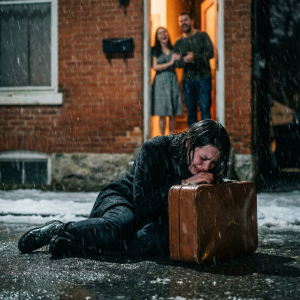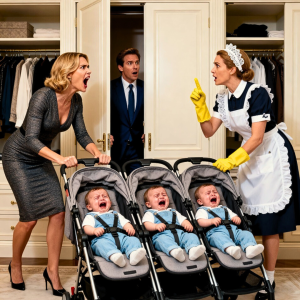
On the evening of June 14, 1981, the peaceful town of Brookfield was forever changed by a mystery that would linger for generations.
In a cozy white house on Maple Drive, Lydia Thompson, a 29-year-old single mother, tucked her three-year-old triplets – Noah, Nora, and Nathan – into their beds.
They were her answered prayers after years of loss and infertility. She read them their favorite story, kissed their foreheads, and whispered gently, “Mommy is right down the hall.”
After a long shift at the diner, exhaustion overtook her. She fell asleep without a single worry.
But everything changed when dawn broke.
She opened the door to their room and froze. The beds were empty. The window stood open, curtains blowing in the morning air. Lydia screamed their names, searching every corner of the house and yard in panic.
Police arrived within minutes. Neighbors reported seeing a dark vehicle parked near the back fence during the night. Fresh tire marks indicated a rushed escape.
Authorities searched relentlessly, but no trace of the children was found. No fingerprints. No items left behind. Nothing.
Rumors swirled through town. Some whispered about a child trafficking ring. Others accused Lydia of staging it. But she never wavered.
“My children are alive. Someone took them,” she repeated through tears, day after painful day.
Years passed. The case went cold. Lydia kept the children’s room exactly as it was—beds made, toys neatly arranged, clothes still folded in drawers. Every year on their birthday, she baked three small cakes and made the same wish: Bring them back to me.
Three decades later, in 2011, everything changed…

One rainy afternoon, she received a call from Detective Mark Reynolds, who had worked the original case. His tone was cautious but filled with urgency. “Lydia,” he said, “you need to come to the station. We may have something.”
At the station, he placed a faded photograph on the desk. It was taken at a community festival in 1995, in another state. In the background stood three children, around twelve years old—a boy and girl beside each other, another boy slightly behind.
Lydia’s breath caught. “That’s them,” she whispered. “Those are my children.”
The image was verified. Investigators traced leads that pointed to a woman named Patricia Doyle, a nurse who had disappeared from Brookfield shortly after the kidnapping.
She had been seen over the years moving from town to town under false identities, always with the same three children she claimed were relatives.
Eventually, a social worker reported that three adults had recently requested their birth records under names matching Doyle’s aliases.
A meeting was arranged.
Lydia waited in a small office, trembling. The door opened, and three adults in their early thirties walked in. Though grown, their features were unmistakable—Noah’s sharp features, Nora’s green eyes, Nathan’s familiar smile.
For a long second, no one moved.
Then, Nora whispered, voice breaking, “Mom?”
Lydia rushed forward, wrapping her arms around them as tears poured down her face. “My babies,” she sobbed. “You came back to me.”
The triplets revealed they had been raised believing their mother abandoned them. But as they grew older, they questioned the lies. .
When they turned eighteen, they tried to uncover the truth, but without legal documents, it was nearly impossible. They drifted, searching for answers, until finally, a persistent social worker helped connect the missing pieces of their identity.
Patricia Doyle was arrested shortly after, charged with kidnapping and fraud. The story shocked the nation.
But for Lydia, nothing mattered more than the moment she celebrated their thirty-third birthday with them—three cakes, three candles, three voices laughing together at the table she had kept waiting all those years.
Though the past could not be erased, the miracle she had held onto through every lonely night had finally come true.
Her children were alive.
They were home.




